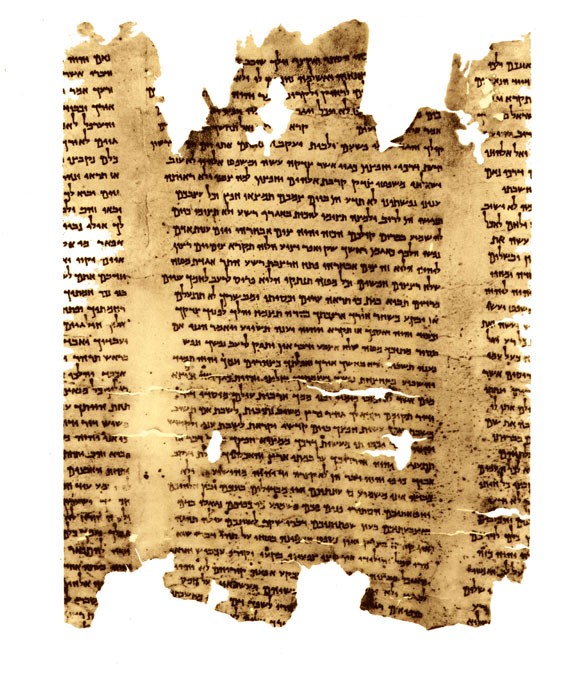死海文書の偽物が発覚したことで広がる不安
[toggle]Sixteen forgeries have been discovered so far in the collections of unsuspecting evangelicals. Experts have suspicions about many more.Mark Lanier thinks if you were going to fake a fragment of the Dead Sea Scrolls to sell to an unsuspecting evangelical collector, you wouldn’t pick Amos 7:17. Psalm 23, maybe. Or Jeremiah 29:11. Even Proverbs 3:13. But not Amos 7:17, which says, “Your wife will become a prostitute in the city, and your sons and daughters will fall by the sword.”
Except maybe that’s exactly what a forger—trying to pass off a scrap of distressed leather as an ancient bit of the Bible preserved in desert caves for two millennia—would want you to think. So in 2013, Lanier made sure an antiquities dealer had legal documentation of the authenticity of three pieces of the Dead Sea Scrolls before he bought them to donate to the Lanier Theological Library in Houston.
“We passed up purchasing a number of other fragments on this issue,” said Lanier, a Texas trial lawyer and philanthropist. “We did due diligence and were assured of the provenance.”
A shadow of suspicion has spread across antiquities collections at US evangelical institutions in recent years as a small team of Dead Sea Scrolls detectives has raised concerns about modern forgeries. The Museum of the Bible reported that all 16 of its prized fragments were fakes, and experts wonder: How many more are out there?
More than 70 pieces of the Dead Sea Scrolls have been offered for sale on the antiquities market in the past two decades. It seems unlikely a criminal would produce and sell 16 forgeries and then just stop.
“Whoever was manufacturing these was responding to the market,” said Kipp Davis, an expert in biblical archaeology and Dead Sea Scrolls forgery. “That market was, for the most part, wealthy evangelicals.”
The Museum of the Bible purchased Dead Sea Scroll fragments in four different lots from four different dealers between 2009 and 2014 as part of its push to collect the most important artifacts from the history of Bible. The scrolls are “the most significant archaeological discovery of the 20th century,” according to Jeffrey Kloha, the museum’s chief curator. They are important to the museum’s mission to tell the story of the sacred text. [/toggle]
死海文書は聖書の元にもなっている古代文書だが、その写本を装った贋作(がんさく)が16個見つかる事件があり、多くの専門家は同様のケースは他にもあるのではないか、と語っている。ラニア神学図書館の創設者、マーク・ラニア氏は言う。
「仮に死海文書の偽物を作ろうと企む人がいるとしても、まさかその聖句にアモス7章17節を選ぶなんて思いませんでした」
それゆえ、主はこう言われる。
お前の妻は町の中で遊女となり息子、娘らは剣に倒れ
土地は測り縄で分けられお前は汚れた土地で死ぬ。(アモス7章17節)
偽造の犯人はその油断を逆手に取ったのか。同図書館に保管されていたこの箇所の古文書は2000年前の聖書写本として偽造されたものであることが分かった。
ラニア氏は2013年、死海文書の断片3個を購入してラニア神学図書館に寄付する前に、法的に有効な保証書があるかどうか古物商に確認している。
「精査の結果、(3個の)出所は保証されましたが、この課題が明らかになってから私たちは多くの断片を購入することを諦めました」とテキサス在住の慈善家、ラニア氏(本職は弁護士)は言う。
死海文書に関する福音派の調査チームがこの偽造問題についての懸念を提起して以来、その影は米国の福音派団体が所蔵する古書全体に落ちている。
聖書博物館(在ワシントンDC)が所有する死海文書の断片16個はすべてが偽物であると報告されており、専門家は「他にもあるのではないか」と疑問をぬぐえない。
過去20年間、骨董品市場で売買されてきた死海文書は70を超える。そのうち16が犯罪者の手による偽造品だったわけだが、それ以外が本物だという見込みは薄い。
偽死海文書の専門家、キップ・デイビス氏(聖書考古学者)は言う。「犯人が誰であれ、ニーズが存在することは分かっていたと思います。買い手のほとんどは、福音派の裕福層です。」
聖書の歴史にとって最も重要な遺物を収集するための一環として、聖書博物館は2009年から2014年の間に4つの異なる業者から計4回、死海文書の断片を購入している。
同博物館のジェフリー・クロハ主任学芸員によれば、死海文書は「20世紀における最も重要な考古学的発見」であり、聖典の物語を伝えることを使命とする同博物館にとって、それは大変な貴重品だ。

聖書博物館で起こった事件
[toggle]The museum invited a team of scholars to study them. When the scholars started to examine them closely, they noticed some of the fragments didn’t look right“They looked like they had been written by unpracticed scribes, or scribes who weren’t very good,” said Davis, who was part of the team.
The museum decided to have all 16 tested by Art Fraud Insights. Under the microscope, experts saw that the text had not been written on fresh parchment, which then decayed over time, but on old leather, distressed to look like it was an ancient manuscript. Colette Loll, CEO of Art Fraud Insights, said the ink going into the cracks and over the broken edges was a telltale sign.
The museum announced the findings in March and apologized for poor judgment in building its collection. It launched a new exhibit displaying the forgeries in October, which tells the story of one of the most amazing archaeological discoveries of the 20th century—and a still-unfolding story of greed and deception.
Scholars praised the museum for its transparency. Other evangelical institutions, however, were left wondering about the legitimacy of their own collections of Dead Sea Scrolls artifacts. All of these collections, built in the past few years as new fragments came up for sale on the antiquities markets, now had red flags, according to Davis. [/toggle]
聖書博物館は、所蔵する死海文書コレクションを調査するために学者団を招いた。詳しい調査が始められてから、学者たちはいくつかの断片が偽物のように見えることに気づいた
チームの一員であったデイビス氏いわく「それは経験が浅いか、作業を得意としない書写生の手によるものに見えた」のだという。
同博物館は、調査団体「アート・フロッド・インサイツ(Art Fraud Insights)」に依頼し、16個すべての破片を調べる決定を下した。顕微鏡で調べたところ、写本が書かれた素材には時間の経過に伴う劣化が見られたものの、それは(本来使われていたはずの)新しい羊皮紙ではなく、羊皮紙に見せかけた古い革に書かれたものであることが判明した。同団体のコレット・ロル代表は、インクが文書のひびや腐食部分の隅にまで入り込んでいることから、これが偽物であることは明白だ、と語っている。
聖書博物館は3月に調査結果を発表し、展示物を構成する際の判断が不十分であったことを陳謝し、10月には、これがいかに「20世紀で最も驚くべき考古学的発見であったはずなのに、それが欲望と欺瞞(ぎまん)にまみれた偽造品であった」ことを語っているかを伝える展示企画を開始させた。
学者たちは博物館の透明性を高く評価したが、それは同博物館の展示を見た多くの福音派関係者に「自分たちの所蔵品は大丈夫だろうか」と疑問を抱かせるものだった。 デイビス氏によれば、これらのコレクションはすべて過去数年の間に古美術品市場で集められたものであり、同様の期間に売り出されていた死海文書は偽物である可能性が高いという。
(続く)
執筆者のゴードン・ゴヴィエーは、Artifaxマガジンの編集者、CT考古学担当ライター。
本記事は「クリスチャニティー・トゥデイ」(米国)より翻訳、転載しました。翻訳にあたって、多少の省略・編集をしています。
出典URLhttps://www.christianitytoday.com/ct/2020/december/dead-sea-scrolls-forgeries-fraud-antiquities-museum-bible.html